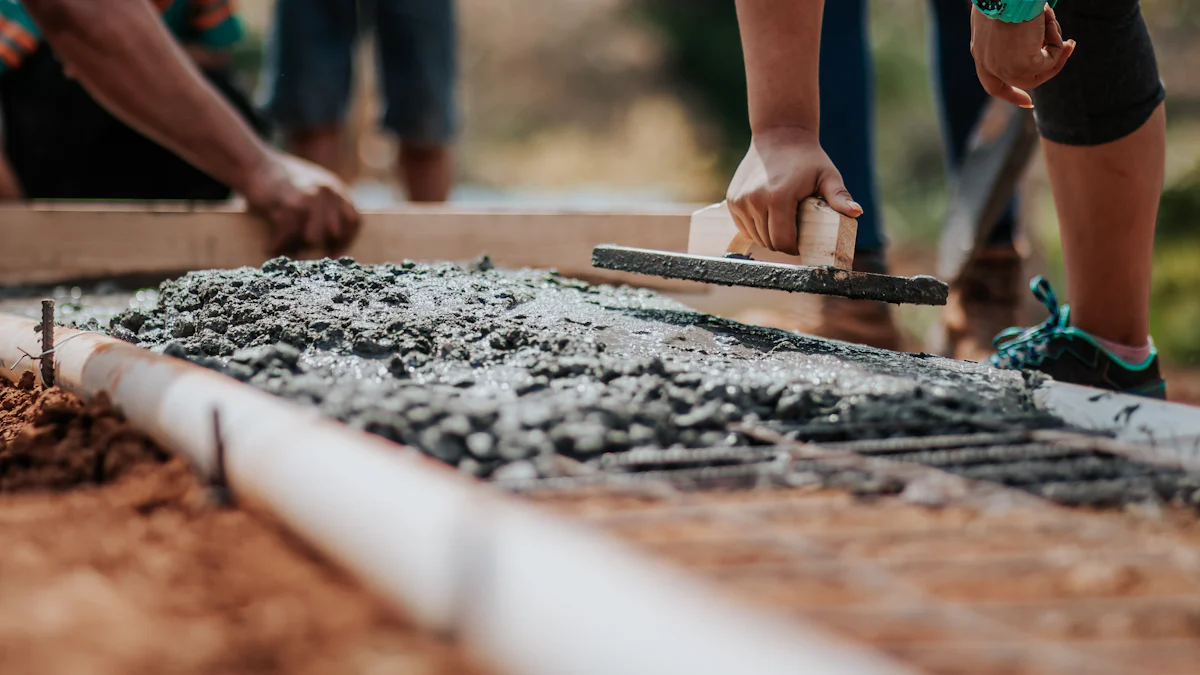
08 Jan Top 3 Concrete Solutions for Long-Lasting Results
Concrete stands out as one of the most durable and versatile building materials. Its ability to withstand harsh weather, heavy loads, and time itself makes it a cornerstone of modern construction. By using advanced concrete solutions, we can create structures that last longer, require minimal maintenance, and reduce environmental impact. For example, sustainable concrete techniques not only enhance durability but also lower carbon emissions. This combination of strength and sustainability ensures that concrete remains a reliable choice for both residential and commercial projects.
High-Performance Concrete Mixes: A Reliable Concrete Solution

High-performance concrete (HPC) has revolutionized the way we approach construction. This advanced material offers unmatched strength and durability, making it a top choice for projects that demand long-lasting results. By incorporating specialized additives and optimized mix designs, HPC delivers superior performance compared to traditional concrete solutions.
Benefits of High-Performance Concrete
Enhanced durability and strength
HPC stands out for its exceptional durability and strength. This can withstand heavy loads and resist wear over time. For instance, studies have shown that adding silica fume to HPC significantly improves its abrasion resistance and mechanical strength. This makes it ideal for structures exposed to constant stress or heavy traffic. Additionally, HPC achieves higher compressive strength, with some mixes reaching up to 73.49 MPa within 28 days when superplasticizers are used. This level of performance ensures that structures remain robust and reliable for decades.
Resistance to environmental factors (e.g., weather, chemicals)
HPC also excels in resisting environmental challenges. Its dense composition protects against harsh weather conditions, such as freezing and thawing cycles, and chemical exposure. This resistance reduces the risk of cracking, corrosion, and other forms of deterioration. By using HPC, builders can minimize maintenance costs and extend the lifespan of their projects, even in the most demanding environments.
Applications of High-Performance Concrete
Infrastructure projects (e.g., bridges, highways)
HPC plays a crucial role in infrastructure development. Bridges, highways, and other large-scale projects benefit from its ability to handle heavy loads and resist environmental wear. For example, bridges constructed with HPC can endure constant traffic and extreme weather without compromising structural integrity. This reliability ensures public safety and reduces the need for frequent repairs.
Commercial and residential construction
HPC is not limited to large infrastructure. It is equally valuable in commercial and residential construction. Skyscrapers, office buildings, and homes built with HPC gain added strength and durability. Its versatility allows architects and engineers to design innovative structures that meet modern demands while maintaining long-term performance.
Tips for Using High-Performance Concrete
Choose the right mix for your project
Selecting the appropriate HPC mix is essential for achieving the desired results. Each project has unique requirements, so it is important to consider factors like load-bearing capacity, environmental exposure, and aesthetic preferences. For eco-conscious builders, low-cement HPC mixtures, such as LC175, offer a sustainable option by reducing cement usage by up to 42% while maintaining excellent performance.
Ensure proper curing and maintenance
Proper curing and maintenance are critical for maximizing the benefits of HPC. Curing helps the concrete achieve its full strength and durability by retaining moisture during the early stages of hardening. Regular maintenance, such as sealing and cleaning, further extends the lifespan of HPC structures. By following these practices, you can ensure that your investment in HPC delivers lasting value.
Concrete Sealers and Coatings: Protecting Your Investment

Concrete sealers and coatings play a vital role in preserving the integrity and appearance of concrete surfaces. They act as a protective barrier, shielding the material from external damage while enhancing its aesthetic appeal. By using the right sealer or coating, you can ensure your concrete surfaces remain durable and visually appealing for years.
Benefits of Using Sealers and Coatings
Protection against moisture and stains
Sealers and coatings provide an essential layer of defense against moisture and stains. For outdoor surfaces, penetrating concrete sealers are particularly effective. They protect against freeze-thaw cycles and prevent water from seeping into the concrete, reducing the risk of cracks and corrosion. Indoors, epoxy concrete sealers offer excellent water repellency and create a thick, glossy surface that resists stains from spills or chemicals. This protection ensures that your concrete surfaces maintain their structural integrity and clean appearance.
Increased lifespan of concrete surfaces
Applying sealers and coatings significantly extends the lifespan of concrete surfaces. For high-traffic areas like driveways or patios, polyurethane concrete sealers provide exceptional durability. They resist wear and abrasion, making them ideal for spaces exposed to heavy use. Additionally, acrylic concrete sealers offer flexibility in finish options, from matte to glossy, while enhancing the surface’s durability. By investing in these protective solutions, you reduce the need for frequent repairs or replacements, saving time and money in the long run.
Applications of Sealers and Coatings
Driveways, patios, and walkways
Sealers and coatings are indispensable for outdoor spaces like driveways, patios, and walkways. These areas face constant exposure to weather, foot traffic, and vehicle loads. Solvent-based concrete sealers are a popular choice for decorative concrete in these spaces. They enhance the color and texture of stamped or patterned surfaces, creating a vibrant and polished look. For homeowners seeking a natural finish, water-based concrete sealers provide a safer, low-chemical option that works well for both indoor and outdoor applications.
Industrial and commercial floors
In industrial and commercial settings, concrete floors endure heavy machinery, spills, and constant movement. Epoxy concrete sealers are ideal for these environments due to their high abrasion resistance and glossy finish. They create a hard, protective layer that withstands wear and tear, ensuring the floor remains functional and attractive. For added protection in areas prone to chemical exposure, penetrating concrete sealers shield the surface from damage while maintaining a natural appearance.
Tips for Applying Sealers and Coatings
Clean and prepare the surface thoroughly
Proper preparation is crucial for achieving the best results when applying sealers and coatings. Begin by cleaning the surface to remove dirt, grease, or debris. Use a pressure washer for outdoor areas or a suitable cleaning solution for indoor surfaces. Ensure the concrete is completely dry before applying the sealer or coating. This step allows the product to adhere properly and provides a smooth, even finish.
Follow manufacturer guidelines for application
Each sealer or coating has specific application instructions. Always read and follow the manufacturer’s guidelines to ensure optimal performance. For example, polyurethane concrete sealers often require an HVLP airless sprayer or microfiber mop for even application. Apply the product in thin, consistent layers and allow sufficient drying time between coats. By adhering to these instructions, you maximize the effectiveness of the sealer or coating and achieve a professional-quality result.
Reinforced Concrete Techniques: Strengthening Concrete Solutions
Reinforced concrete stands as one of the most effective concrete solutions for projects requiring superior strength and durability. By embedding steel reinforcements within the concrete, this technique enhances the material’s ability to withstand various stresses, including tensile, shear, and compressive forces. Unlike plain concrete, which lacks reinforcement, reinforced concrete offers unmatched versatility and resilience, making it a preferred choice for demanding construction projects.
Benefits of Reinforced Concrete
Improved load-bearing capacity
Reinforced concrete significantly improves load-bearing capacity. The combination of concrete’s compressive strength and steel’s tensile strength creates a material capable of supporting heavy loads without compromising structural integrity. For example, bridges and high-rise buildings rely on reinforced concrete to handle immense weight and pressure. This synergy between materials ensures that structures remain stable and secure, even under extreme conditions.
Enhanced resistance to cracking and deformation
Reinforced concrete excels in resisting cracking and deformation. The steel reinforcement embedded within the concrete absorbs tensile stresses, preventing cracks from spreading. This feature is particularly valuable in areas prone to seismic activity or shifting soil. By using reinforced concrete, builders can reduce the risk of structural failure and extend the lifespan of their projects.
Applications of Reinforced Concrete
High-rise buildings and skyscrapers
High-rise buildings and skyscrapers depend on reinforced concrete for their strength and stability. The material’s ability to handle both tension and compression makes it ideal for constructing tall structures. Reinforced concrete also allows architects to design innovative and complex shapes, pushing the boundaries of modern architecture. Its durability ensures that these towering structures can withstand wind pressure, heavy loads, and environmental challenges.
Foundations and retaining walls
Reinforced concrete is essential for foundations and retaining walls. These structures require exceptional strength to support the weight of buildings and resist soil pressure. Reinforced concrete provides the necessary stability, preventing shifts or collapses over time. For retaining walls, the material’s resistance to cracking ensures long-term performance, even in areas with fluctuating moisture levels or uneven terrain.
Tips for Implementing Reinforced Concrete
Use high-quality reinforcement materials
The quality of reinforcement materials directly impacts the performance of reinforced concrete. Always choose high-grade steel bars or mesh to ensure optimal strength and durability. Low-quality materials may compromise the structure’s integrity, leading to potential failures. Additionally, consider using corrosion-resistant reinforcements in environments exposed to moisture or chemicals to enhance longevity.
Ensure proper placement and alignment of reinforcements
Proper placement and alignment of reinforcements are critical for achieving the desired results. Reinforcements must be positioned accurately within the concrete to distribute stresses evenly. Use spacers and supports to maintain the correct alignment during pouring. This attention to detail ensures that the reinforced concrete performs as intended, providing a reliable and long-lasting solution for your construction needs.
The three concrete solutions discussed—high-performance mixes, sealers and coatings, and reinforced techniques—offer unmatched durability and versatility. Each solution addresses specific needs, ensuring long-lasting results for various projects. Choosing the right option depends on understanding your project’s requirements, such as load capacity, environmental exposure, or aesthetic goals. Sustainable options also provide eco-friendly benefits, reducing carbon emissions while maintaining strength. I encourage you to consult professionals or explore these solutions further to ensure your construction projects achieve optimal performance and longevity.


